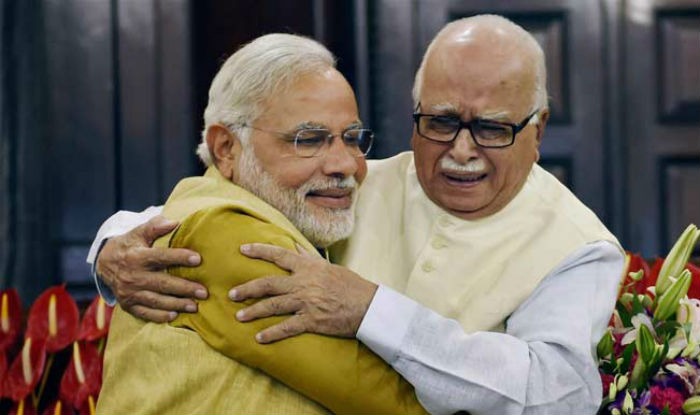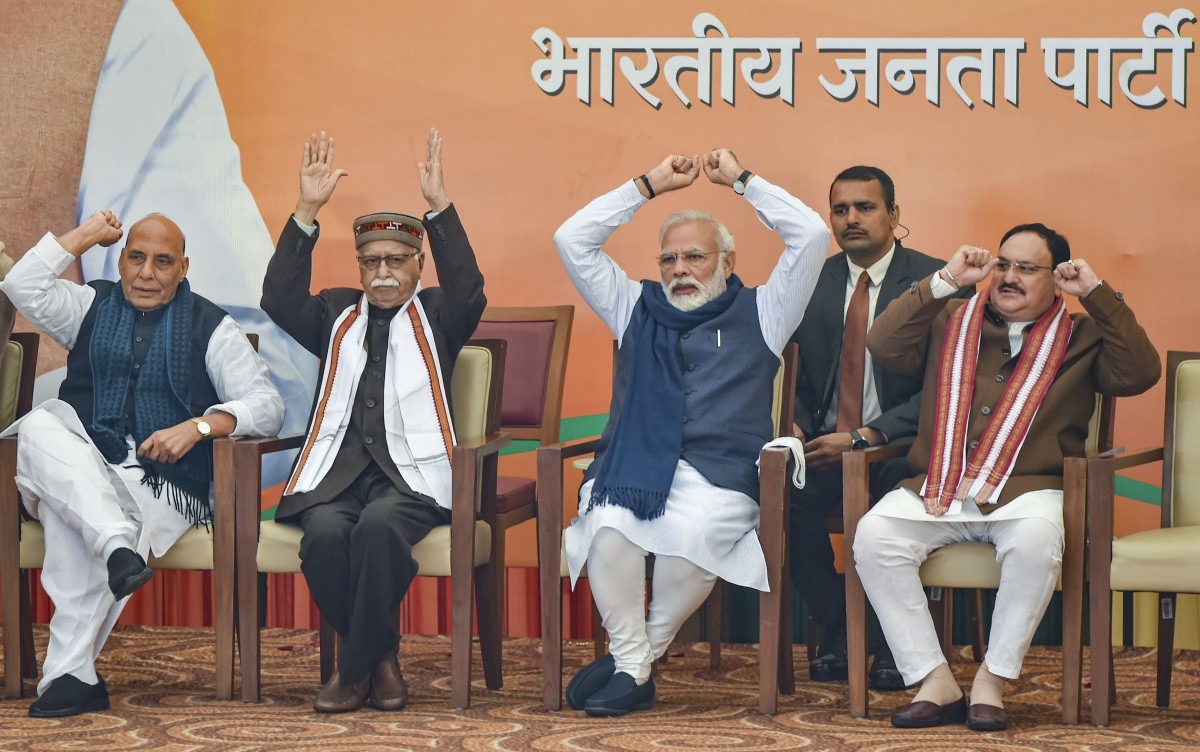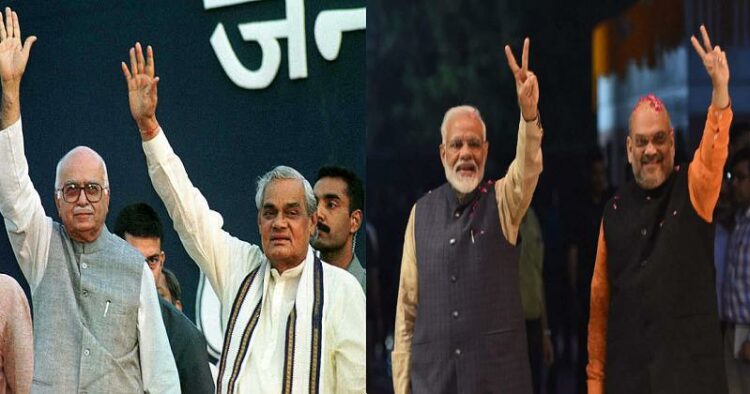Very few had imagined that the BJP would be able to become the world’s largest party when it was founded on April 6, 1980. The party originated from Jana Sangh, which had merged with the Janata Party in 1977 but three years later splintered.
BJP had emerged from the Jana Sangh, which was formed by Syama Prasad Mookerjee in 1951. After the Emergency was imposed by the then Congress-led Government, the Jana Sangha merged with some other parties to form the ‘Janata Party’ in 1977. Three years later, the Janata Party dissolved and its members formed the Bharatiya Janata Party with Atal Bihari Vajpayee as its first president.
It works on the ideology of integral humanism proponent by Jana Sangh’s former President Deendayal Upadhaya.
From just two seats in the 1984 General elections to winning 303 seats in the 2019 elections, the BJP has established itself as the biggest political force in India.
Atal-Advani’s Arithmetic
The rise of BJP started mainly with the Ram temple movement in 1990s, but it had influence in Hindi heartland states. In the 1989 General Elections the BJP won 85 Lok Sabha seats. The much famous ‘Ram Rath Yatra’-led by following Lal Krishna Advani in 1990, the party grew its strength and in the 1991 elections; it increased its strength winning 120 seats.
Slow and steadily, the BJP emerged as the single largest party in 1996 under the leadership of former Prime Minister Atal Bihari Vajpayee.
In 1996 General election, the BJP won as many as 161 seats. The party for the first time formed Government in 1996 for 13 days and then in the next general polls in 1998, the BJP’s tally increased to 182 seats in the Lok Sabha and formed a coalition government called the National Democratic Alliance (NDA), which lasted 13 months when it lost a no-confidence motion by a single vote.
A year later, the BJP came back to power as the NDA won 270 seats in the General elections on its own, with the party again getting 182 seats. And Vajpayee became Prime Minister for the third time.
It was Atal Bihari Vajpayee’s and LK Advani’s pragmatic leadership which helped the party to create new alliances and led the first non-Congress Government which completed its five-year tenure.
Shining India and Blunder of declaration of pre-poll
Massive victories in the assembly elections in Madhya Pradesh, Rajasthan and Chhattisgarh made BJP over-confident and it announce pre-poll with a slogan of India Shining.
In 2004, Riding on overconfidence because of its welfare schemes and path breaking initiatives BJP went for early elections. But, the move proved to be a blunder as failed to get the majority and was limited to 138 seats.
The party paid no attention in states like Tamil Nadu and Andhra Pradesh where it had no organisational strength and needed strong allies. Even in Uttar Pradesh where the BJP had won 25 seats in 1999, it managed to get only 10 seats.
In 2009 General elections, BJP’s quest to regain power after failed again and won only 116 seats.
A change of fortunes happened in 2014 with the emergence of Narendra Modi on the national scene.
The Arrival of Narendra Modi
Following a hat-trick, catapulting his party to power in Gujarat for the third consecutive time was the nodal point in Modi’s march to the Centre.
In 2013, the then BJP president Rajnath Singh announced Narendra Modi as the Prime Ministerial candidate of the party for the 2014 Lok Sabha elections. After accepting the nomination, Modi (then the CM of Gujarat) asked the party workers to make a committed effort to uproot the Congress. The appeal was answered, and BJP, led by Narendra Modi, received a historic mandate in 2014.

Under his leadership the BJP won 282 seats on its own. And this was the first party in three decade when any party had got majority on its own.
Its stupendous performance has been propelled as it won 73 out of 80 seats in Uttar Pradesh, won all 26 and 25 seats in Gujarat and Rajasthan respectively. It won 12 of the 14 seats in Jharkhand. The party which had drawn a blank in 2009 won all seven seats in the National Capital. In Madhya Pradesh BJP won a high total of 27 seats of the total 29.
The party also expanded its footprint beyond Hindi heartland, especially in the Northeast region.
Following a majestic performance in Uttar Pradesh, Amit Shah, who was in charge of the state, was rewarded with party’s top post.
With this a new era of Modi-Shah duo or Atal-Advani 2.0 started which led to the party’s victory in various state assembly elections and the party was ruling in the 18 states at one point of time.
PM Modi, who came to power showcasing Gujarat Model and development, and gave a slogan ‘Sabka Sath Sabka Vikas’ and worked on public welfare schemes. Ujjwala Yojna, Swachh Bharat Abhiyan, Jan Dhan accounts are some of the transformational schemes which made the Government to enter into a different vote bank that was alienated with the BJP due to its Hindutva ideology. Many villages witnessed electricity for first time under Deen Dayal Upadhyaya Gram Jyoti Yojana.

Modi worked on national security and sought to remind the people that the internal security situation had never been as secure as it is today, no terror strikes took place on the civilians and outside the Kashmir Valley since 2014.
Notably, BJP is following Zero tolerance policy towards terrorism as a result gave befitting reply to Pakistan or China, whether it is Uri’s Surgical strike, Pulwama Air Strike or thrashing Chinese army in Galwan valley.
Narendra Modi also empowered the Muslim women by promising to do away with the evil practice of triple talaq.
In 2019, the party scripted a historic victory under Prime Minister Narendra Modi, securing a consecutive majority in the lower house on its own. For the first time BJP crossed the 300-mark on its own.
Modi-led BJP built upon a strategy to win more seats in the North-east, West Bengal and Odisha to offset the losses they could suffer in states such as Uttar Pradesh, Madhya Pradesh, Rajasthan and Chhattisgarh. The hardwork pays off and the party won a record 19 seats in West Bengal.
BJP has now become the central focal point of Indian politics.
As the BJP grew from strength to strength, its principal opponent and India’s oldest party Congress witnessed a constant decline in state and national politics. Congress, which ruled India for decades, saw its seat share in Lok Sabha from a high of 415 in 1984 to just 44 in 2014 and 52 in 2019 elections.
Recently, in an opinion piece in the Wall Street Journal authored by Walter Russell Mead states, “India’s ruling Bharatiya Janata Party is, from the standpoint of American national interests, the most important foreign political party in the world”.
The total number of BJP members has now reached near 20 crore, its highest ever, with the party set to add crores of new entrants. It has 302 MPs in Lok Sabha, 93 in Rajya Sabha, 1420 MLAs and Government in 16 States and UTs.
On the occasion of party’s 44th foundation day PM Modi said, “Selfless service to the nation, a virtue of Bhagwan Hanuman, is the inspiration for BJP cadres”.
The Prime Minister slammed people with ‘baadshahi’ mindset, alleging they have been insulting the poor, backwards and deprived since 2014. The opposition parties never imagined that Article 370 would be history one day and they cannot digest the work BJP is doing, he said.
“Today, they have become so desperate that they have openly started saying ‘Modi teri kabar khudegi’,” PM Modi said.
Taking a dig at the opposition, the Prime Minister said that the identity of Congress is dynasty, nepotism and corruption whereas BJP’s political culture is inclusive.
“Unlike opposition parties, who used the slogan of social justice for political gains, BJP strives for social justice and employment of all segments and the free ration to 80 crore is a living example as it is being given without any discrimination.
Addressing the partyworkers, PM Modi said, “Parties fighting existential crisis will keep conspiring against us. The poor, deprived, dalits and tribals are protecting the lotus (BJP)”.



















Comments